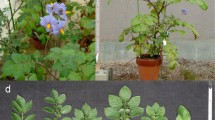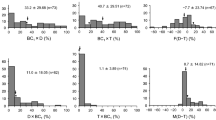Summary
The main aim of the experiment was to study the behaviour of seven long-day adapted clones of Solanum tuberosum ssp. andigena (A) and three varieties of S. tuberosum ssp. tuberosum (T) in an incomplete diallel cross. The four groups of crosses, TxT, TxA, AxT and AxA, held 2, 12, 20 and 21 populations, respectively. Eleven of the intersubspecific crosses were exact reciprocals. Thirty random clones per population were grown as second clonal generation in an incomplete block design with four replications in plots of two plants per clone in 1980, the parents included in many plots. Data were recorded on ten characters.
The results showed that group TxA gave the highest tuber yield and AxT the second highest. The F-values indicated highly significant genotypic effects for all characters in all populations. The mean genotypic coefficients of variation (GCV), were the highest for group AxA for all characters. The ANOVA, based on population means showed significant mean squares for general combining abilities (GCA) and for differences of reciprocalls for all characters; the specific combining ability (SCA) mean squares were significant only for date of emergence, plant height and haulm type. Almost all GCA effects of the parents were significant positive or negative. Several populations showed also significant SCA effects. The correlations between the GCA effects and the parental values were of about the same magnitude as the heritabilities; those between the population means and the midparental values were slightly lower.
Compared to the midparental values, most populations showed significant positive heterosis for date of emergence, haulm type, number of tubers and under water weight; all populations had significant negative heterosis for mean tuber weight and nearly all for plant height and general impression. All populations from groups TxT and AxA had significant negative heterosis for tuber yield and so had 13 out of the 20 populations from group AxT, while seven of the 12 from group TxA showed significant positive and four significant negative heterosis. The average heterosis for tuber yield of group TxT was −11%, of TxA 3.4%, of AxT−9% and of AxA−18%. The highest mean tuber yields were obtained from crosses with a very high yielding A-parent as female, while the heterosis was negative. Though significant differences between the 11 reciprocals occurred for all characters, consistent differences occurred only for tuber yield. Averaged over the 11 crosses the TxA populations outyielded their exact reciprocals by 10.7%. For the highest tuber yields in A-T crosses, therefore, the tuberosum cytoplasm seems to be preferable. By contrast for a high male fertility the andigena cytoplasm is preferable.
Similar content being viewed by others
References
Cubillos, A.G. & R.L. Plaisted, 1976. Heterosis for yield in hybrids between S. tuberosum ssp. tuberosum and tuberosum ssp. andigena. Am. Potato J. 53: 143–150.
Dalianis, C.D., R.L. Plaisted & L.C. Peterson, 1966. Selection for freedom from after cooking darkening in a potato breeding program. Am. Potato J. 43: 207–215.
Garretsen, F. & M. Keuls, 1973. Analysis of genetic variation in an imcomplete diallel cross. proc. 1st. meeting section Biometrics in Plant Breeding of Eucarpia. Hannover 1973: 24–35.
Glendinning, D.R., 1969. The performance of progenies obtained by crossing Groups Andigena and Tuberosum of Solanum tuberosum. Eur. Potato J. 12: 13–19.
Glendinning, D.R., 1975a. Neo-Tuberosum: new potato breeding material. 1. The origin, composition, and development of the Tuberosum and Neo-Tuberosum gene pools. Potato Res. 18: 256–261.
Glendinning, D.R., 1975b. Neo-Tuberosum: new potato breeding material. 2. A comparison of Neo-Tuberosum with unselected Andigena and with Tuberosum. Potato Res. 18: 343–350.
Grun, P., 1974. Cytoplasmic sterilities that separate the Group Tuberosum cultivated potato from its putative tetraploid ancestor. Evolution 27: 633–643.
Grun, P. & J.E. Staub, 1979. Evolution of tetraploid cultigens from the view of cytoplasmic inheritance. In: Rpt. of the planning conference on the exploration taxonomy and maintenance of potato germ plasm II, held at CIP, Lima, Peru, 1979: 141–152.
Harlan, H.V., M.L. Martini & Harland Stevens, 1940. A study of methods in barley breeding. USDA. Techn. Bull. 720.
Hawkes, J.G., 1967. The history of the potato. J. Roy. Hort. Soc. 92: 207–224, 249–262, 288–302, 364–365.
Hoopes, R.W., R.L. Plaisted & A.G. Cubillos, 1980. Yield and fertility of reciprocal-cross Tuberosum-Andigena hybrids. Am. Potato J. 57: 275–284.
Howard, H.W., 1963. Some potato breeding probiems. Pl. Breed. Inst. Cambridge, Ann. Rpt. 1961/62: 5–21.
John Innes Institute (Paxman, G.J.), 1966. Heterosis in Andigena-Tuberosum hybrids. Fifty sixth Ann. Rpt. 1965: 51–53.
Kaminski, R., 1977. Variability and heritability of morphological and physiological characters of potato. Genetica Polonica 18: 115–123.
Killick, R.J., 1977. Genetic analysis of several traits in potatoes by means of a diallel cross. Ann. Appl. Biol. 86: 279–289.
Maris, B., 1969. Studies on maturity, yield, under water weight and some other characters of potato progenies. Euphytica 18: 297–319.
Maris, B., 1986. The effect of seed tuber weight on characters in the first and the second clonal generation of potato populations. Euphytica 35: 465–482.
Mendoza, H.A. & F.L. Haynes, 1974. Genetic basis of heterosis for yield in autotetraploid potatoes. Theor. Appl. Genet. 45: 21–25.
Mullin, R. & F.I. Lauer, 1966. Breeding behavior of F1 and inbred potato clones. Am. Soc. Hort. Sci. 89: 449–455.
Plaisted, R.L., 1972. Utilization of germ plasm in breeding programs. Use of cultivated tetraploids. In: Prospects for the potato in the developing world. CIP, La Molina, Peru. 1972: 90–99.
Plaisted, R.L., L.L. Sanford, W.T. Federer, A.E. Kehr & L.C. Peterson, 1962. Specific and general combining ability for yield in potatoes. Am. Potato J. 39: 185–197.
RascoJr., E.T., R.L. Plaisted & E.E. Ewing, 1980. Photoperiod response and earliness of S. tuberosum ssp. andigena after six cycles of recurrent selection for adaptation to long days. Am. Potato J. 57: 435–447.
Ross, R.W. & P.R. Rowe, 1965. Inventory of tuber-bearing Solanum species. Agric. Expt. Sta., Univ. of Wisc., Bull. 533, 73 pp.
Sanford, J.C. & R.E. HannemanJr., 1982a. Large yield differences between reciprocal families of Solanum tuberosum. Euphytica 31: 1–12.
Sanford, J.C. & R.E. HannemanJr., 1982b. A possible heterotic threshold in the potato and its implications for breeding. Theor. Appl. Genet. 61: 151–159.
Simmonds, N.W., 1969. Variability in crop plants, its use and conservation. Biol. Rev. 37: 422–465.
Simmonds, N.W., 1969. Prospects for potato improvement. Ann. Rpt. Scott. Pl. Breed. Sta. 1968–69: 18–38.
Staub, J.E., P. Grun & V. Amoah, 1982. Cytoplasmic evaluations during substitution backcrossing in Solanum. Potato Res. 25: 299–319.
Tai, G.C.C., 1974. A method for quantitative genetic analysis of early clonal generation seedlings of an asexual crop with special application to a breeding population of the potato (Solanum tuberosum L.). Theor. Appl. Genet. 45: 150–156.
Tai, G.C.C., 1974. Estimation of general and specific combining abilities in potato. Can. J. Genet. Cytol. 18: 463–470.
Tai, G.C.C. & D.A. Young, 1984. Early generation selection for important agronomic characteristics in a potato breeding population. Am. Potato J. 61: 419–434.
Tarn, T.R. & G.C.C. Tai, 1973. Heterosis in F1 hybrids between Group Andigena and Group Tuberosum potatoes. Am. Potato J. 50: 337.
Tarn, T.R. & G.C.C. Tai, 1977. Heterosis and variation of yield components in F1 hybrids between Group Tuberosum and Group Andigena potatoes. Crop Sci. 17: 517–521.
Tarn, T.R. & G.C.C. Tai, 1983. Tuberosum x Tuberosum and 07 Tuberosum x Andigena potato hybrids: comparisons of families and parents, and breeding strategies for ANdigena potatoes in long-day temperate environments. Theor. Appl. Genet. 66: 87–91.
Thompson, P.G., H.A. Mendoza & R.L. Plaisted, 1983. Estimation of genetic parameters for characters related to potato propagation by true seed (TPS) in an andigena population. Am. Potato J. 60: 393–401.
Thompson, P.G. & H.A. Mendoza, 1984. Genetic variance estimates in a heterogenous potato population propagated from true seed (TPS). Am. Potato J. 61: 697–702.
Veilleux, R.E. & F.I. Lauer, 1981. Breeding behavior of yield components and hollow heart in tetraploid-diploid vs. conventionally derived potato hybrids. Euphytica 30: 547–561.
Yildirim, M.B. & C.F. Çalişkan, 1985. Genotypic x environment 07 interactions in potato (Solanum tuberosum L.). Am. Potato J. 62: 371–375.
Author information
Authors and Affiliations
Rights and permissions
About this article
Cite this article
Maris, M. Analysis of an incomplete diallel cross among three ssp. tuberosum varieties and seven long-day adapted ssp. andigena clones of the potato (Solanum tuberosum L.). Euphytica 41, 163–182 (1989). https://doi.org/10.1007/BF00022425
Received:
Accepted:
Issue Date:
DOI: https://doi.org/10.1007/BF00022425




